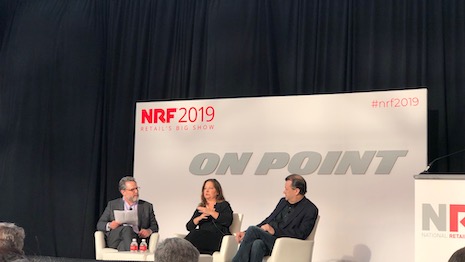 Neiman Marcus The Art of Fashion campaign. Image credit: Neiman Marcus
Neiman Marcus The Art of Fashion campaign. Image credit: Neiman Marcus
NEW YORK – Retailers need to constantly evaluate their digital infrastructures and nurture relationships with solution providers to successfully introduce technological innovations for shoppers.
Speaking at the National Retail Federation’s Big Show on Jan. 15, digital retail experts detailed their experiences and challenges in introducing innovations to traditional retailers. In addition to making supply chains more efficient, applying technology in a well thought out manner can be beneficial to consumers.
“Applying new techniques and new technology to solve problems for the customer is [my] definition of innovation,” said Scott Emmons, founder and former head of the Neiman Marcus iLab, Dallas.
“The pendulum has shifted towards the digital side,” he said. “How do you make shopping Neiman Marcus a unique experience online?”
Innovative relationships
In a conversation moderated by GELF cofounder Scott Silverman, Mr. Emmons and Laura Nawrocki, senior director of digital strategy and innovation at Guess, Inc., elaborated on how their roles have evolved to include technology and innovation.
When reviewing digital strategies, retailers must take into account how shopping experiences are reflected online.
Moderator Scott Silverman and speakers Laura Nawrocki and Scott Emmons
Due to constraints regarding resources and budgets, many brands turn to solution providers to tackle specific challenges. For instance, as Guess looks to expand its Chinese audience it has developed a working relationship with ecommerce giant Alibaba.
Communication is crucial, as Ms. Nawrocki explained that divergent plans can hamper these partnerships.
To be successful, Ms. Nawrocki and Mr. Emmons also suggested that solution providers understand retailers' organizational structures and show how to pilot a program in an economical way.
Not all innovative ideas that come into fruition become popular among customers, however.
Mr. Emmons, who is now the chief technology officer at innovation consultancy TheCurrent Global, cited “fling walls” as a failed experiment at Neiman Marcus. Shoppers did not respond to the digital lookbooks and mostly ignored them.
Neiman Marcus is looking to omnichannel to boost sales. Image credit: Neiman Marcus
Too often, shoppers and retailers are not on the same page when it comes to the future of fashion technology, with many brands investing in high-tech features that have little to no traction among today's customers. According to a report from Klarna, 42 percent of retailers are prioritizing online shopping technology, indicating a disconnect between strategy and consumer preferences as bricks-and-mortar experiences are neglected (see story).
“You need to ask customers if they like the idea before you invest in it,” Mr. Emmons said.
Adapting tech
Both executives agreed that technology innovation is a worthwhile investment for retailers.
A growing number of retailers see the power of harnessing the Internet of Things, especially as a way to improve store operations and inventory management.
According to a report from Retail Systems Research, 69 percent of retailers believe IoT will drastically change the way they do business, up from 53 percent in 2017. The interconnectivity of devices from smartphones and cars to home appliances and more is already having an impact on consumers' everyday lives (see story).
Luxury retailers continue to embrace more multichannel tools as a way bringing those customers in and giving them a more seamless experience.
One strategy that Neiman Marcus has embraced is giving all of its sales associates the digital tools to usher customers through the in-store purchasing process with the same level of care and personalization that they get from online shopping (see story).
“Neiman Marcus has always been an innovator in its 111-year long history,” Mr. Emmons said. “We needed to add technology into the conversation.”


